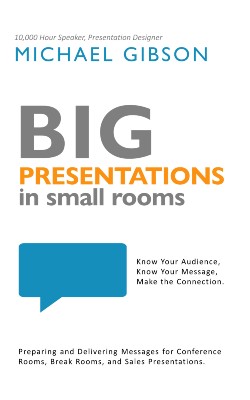You know your audience. You know your message. You are making the connection.
And then it happens. A hand goes up or a voice interrupts and you hear what you dread—the random presentation interruption.
I have a friend who works for a large municipality. He jokes about the random questions asked during city council meetings.
Here’s the way he describes it.
An employee is reporting on the implementation of new financial software. Things are going well. Boring, but well. After all, it is a report about financial software.
And then it happens. A council member clears her throat, the verbal equivalent of raising her hand, and out comes the random question:
“How will this affect the migratory pattern of northern snow geese?”
The presenter pauses, looks at the council member, looks at the other council members, looks around for a camera (and there are cameras, this thing is live), and struggles to compose a response.

Sound familiar?
Or perhaps the interruption is not a question; it is an observation or suggestion. And it reveals a lack of understanding of your work. It might also reveal a lack of preparation or attention on the part of the person making the observation. It proves that they did not read the information that was sent out prior to this meeting. Or it might prove that they were not listening to the previous two minutes of your presentation where you addressed the issue they are now targeting.
Have you ever experienced a random interruption? It is a unique experience. So how do you prepare for it?
The answers involve wise predictions, pre-planned responses, silence, and discovery.
PRESENTATION INTERRUPTIONS: KNOW YOUR AUDIENCE & LOOK FOR PATTERNS
The first tip is to be prepared.
Sound impossible?
How do you prepare for random interruptions?
Use wisdom to predict the possibilities. Here’s how.

KNOW YOUR AUDIENCE
First, know your audience. What roles are represented in your audience? What personalities are present? These two things, roles and personality, will form the lenses through which the audience members view your content.
For example, I worked with a diverse non-profit board. One member was a detail-oriented retired firefighter whose former job involved doing fire inspections. Any time we discussed events or facilities, it was no surprise when he asked questions or made observations and suggestions about crowd size, access to fire exits, and other similar issues. His role and his personality made the questions more predictable.
LOOK FOR PATTERNS
Another tip is to look for patterns. Do certain questions seem to come up every time a specific topic is discussed? This could be tied to the role and responsibility of a single audience member, it could be due to the nature of the organization, or it could be due to a group dynamic that is created each time this audience gathers for this purpose.
If you can identify the patterns, you will be less surprised by the interruptions—and you can be better prepared to address them.
PRESENTATION INTERRUPTIONS: HAVE A MULTI-PURPOSE RESPONSE
The first tip is to be prepared, the second is to have a multi-purpose response.
Your multi-purpose response should receive careful consideration. Here are two characteristics of a good multi-purpose response.

RESPECTFUL
Know your audience. Based on that knowledge, treat them with respect—in ways that will seem respectful to them. Avoid condescension, impatience, and inappropriate familiarity. Respect the people and the situation.
RESPONSIBLE
The second characteristic is responsibility. If the question involves decisions you have made, own those decisions. Do not make excuses or throw the blame on other people. Be responsible.
If your multi-purpose response commits to (or implies) action on your part, be responsible to follow through. If you do not plan to take any further action, use a response that does not commit to it.
During a class that addressed the concept of multi-purpose responses, I asked for examples from class members. Here are a few they shared.
Thank you for your feedback. We will include it in our final recommendation.
We understand, and we will take this into consideration.
We are still compiling the data and we will get back to you as soon as possible.
What would work for you? It is worth careful consideration.
PRESENTATION INTERRUPTIONS: SILENCE IS BETTER THAN NONSENSE
When you experience a random interruption, you will feel pressure to respond immediately. This is challenging. The seconds seem like hours as you compose your thoughts. However, a few seconds of silence might be what you need. It is just a few seconds and what it can achieve is worth the wait.
Silence is better than nonsense. The silence allows you to quickly filter information and remind yourself to be respectful and responsible with your words. It also shows that you are composed and willing to think. You are not providing “knee-jerk” reactions, you are providing thoughtful responses. You are focused.
If you take too long, it does become awkward, but a few seconds is acceptable.

PRESENTATION INTERRUPTIONS: ADMIT WHEN YOU DON’T KNOW & COMMIT TO FINDING ANSWERS
As you take a few seconds to consider your response, you might realize that you do not have the information needed to answer the question. That is when it is time to take responsibility for discovery.
“I don’t know” is seldom an acceptable response.
“I don’t know, but I will find out.” is better received. And if you attach a date to it and say,
“I don’t know, but I will find out and will let you know by the end of the week” is even better.
PRESENTATION INTERRUPTIONS: DOES IT REQUIRE AN IMPROMPTU SPEECH?
Some questions and observations will address issues you can address right then. If that is the case, then this qualifies as an impromptu opportunity. There is a blog and a podcast that address impromptu speeches and will equip you to take advantage of the opportunity. Check them out!
PRESENTATION INTERRUPTIONS: ENCOURAGEMENT
Random interruptions can be stressful and frustrating. Thankfully, there are things you can do to prepare yourself for them.
Remember to be prepared by knowing your audience and looking for patterns.
Take some time to formulate multi-purpose responses that will work for each audience you address.
Remember that silence is better than nonsense and that if you don’t know the answer to a question, you should be willing to find out.
Remember these things and you will be able to make Big Presentations in Small Rooms—even when there are random interruptions.
Want to know more? Keep reading the blog!
Do you prefer to listen? Check out The Big Presentations Podcast!
Want to know even more? Order the book Big Presentations in Small Rooms!




